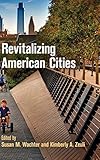Revitalizing American Cities / ed. by Susan M. Wachter, Kimberly A. Zeuli.
Material type: TextSeries: The City in the Twenty-First CenturyPublisher: Philadelphia : University of Pennsylvania Press, [2013]Copyright date: ©2014Description: 1 online resource (312 p.) : 40 illusContent type:
TextSeries: The City in the Twenty-First CenturyPublisher: Philadelphia : University of Pennsylvania Press, [2013]Copyright date: ©2014Description: 1 online resource (312 p.) : 40 illusContent type: - 9780812245554
- 9780812208887
- City planning -- United States -- History -- 21st century
- Urban renewal -- United States -- History -- 21st century
- Urban renewal -- United States
- Urbanization -- United States -- History -- 21st century
- Political Science
- POLITICAL SCIENCE / Public Policy / City Planning & Urban Development
- Economics
- Political Science
- Public Policy
- Urban Studies
- 307.3/4160905 23
- online - DeGruyter
- Issued also in print.
| Item type | Current library | Call number | URL | Status | Notes | Barcode | |
|---|---|---|---|---|---|---|---|
 eBook
eBook
|
Biblioteca "Angelicum" Pont. Univ. S.Tommaso d'Aquino Nuvola online | online - DeGruyter (Browse shelf(Opens below)) | Online access | Not for loan (Accesso limitato) | Accesso per gli utenti autorizzati / Access for authorized users | (dgr)9780812208887 |
Frontmatter -- CONTENTS -- Introduction -- PART I. City Decline and Revival -- CHAPTER 1. The Historical Vitality of Cities -- CHAPTER 2. The Growth of Metropolitan Areas in the United States -- CHAPTER 3. The Relationship Between City Center Density and Urban Growth or Decline -- CHAPTER 4. Central Cities and Metropolitan Areas: Manufacturing and Nonmanufacturing Employment as Drivers of Growth -- PART II. Discovering Resilience -- CHAPTER 5. Lessons from Resurgent Mid- Sized Manufacturing Cities -- CHAPTER 6. Revitalizing Small Cities: A Comparative Case Study of Two Southern Mill Towns -- CHAPTER 7. Parallel Histories, Diverging Trajectories: Resilience in Small Industrial Cities -- PART III. Land and Neighborhood Policy -- CHAPTER 8. A Market- Oriented Approach to Neighborhoods -- CHAPTER 9. Transformation Is Messy Work: The Complex Challenge of Spatial Reconfiguration in America's Legacy Cities -- CHAPTER 10. Tactical Options for Stable Properties -- PART IV. The New Economy and Cities -- CHAPTER 11. Anchor Institutions in the Northeast Megaregion: An Important But Not Fully Realized Resource -- CHAPTER 12. Fields, Factories, and Workshops: Green Economic Development on the Smaller- Metro Scale -- CHAPTER 13. Promoting Workforce Readiness for Urban Growth -- Afterword -- NOTES -- CONTRIBUTORS -- BIBLIOGRAPHY -- INDEX -- ACKNOWLEDGMENTS
restricted access online access with authorization star
http://purl.org/coar/access_right/c_16ec
Small and midsized cities played a key role in the Industrial Revolution in the United States as hubs for the shipping, warehousing, and distribution of manufactured products. But as the twentieth century brought cheaper transportation and faster communication, these cities were hit hard by population losses and economic decline. In the twenty-first century, many former industrial hubs-from Springfield to Wichita, from Providence to Columbus-are finding pathways to reinvention. With innovative urban policies and design, once-declining cities are becoming the unlikely pioneers of postindustrial urban revitalization.Revitalizing American Cities explores the historical, regional, and political factors that have allowed some industrial cities to regain their footing in a changing economy. The volume discusses national patterns and drivers of growth and decline, presents case studies and comparative analyses of decline and renewal, considers approaches to the problems that accompany the vacant land and blight common to many of the country's declining cities, and examines tactics that cities can use to prosper in a changing economy. Featuring contributions from scholars and experts of urban planning, economic development, public policy, and education, Revitalizing American Cities provides a detailed, illuminating look at past and possible reinventions of resilient American cities.Contributors: Frank S. Alexander, Eugenie L. Birch, Paul C. Brophy, Steven Cochrane, Gilles Duranton, Sean Ellis, Kyle Fee, Edward Glaeser, Daniel Hartley, Yolanda K. Kodrzycki, Sophia Koropeckyj, Alan Mallach, Ana Patricia Muñoz, Jeremy Nowak, Laura W. Perna, Aaron Smith, Catherine Tumber, Susan M. Wachter, Kimberly A. Zeuli.
Issued also in print.
Mode of access: Internet via World Wide Web.
In English.
Description based on online resource; title from PDF title page (publisher's Web site, viewed 30. Aug 2021)


